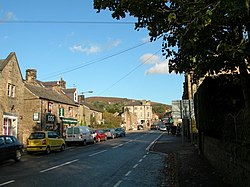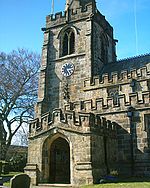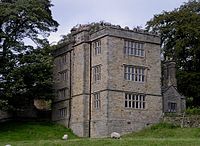Hathersage
| Hathersage | |
| Derbyshire | |
|---|---|
 Main Road, Hathersage | |
| Location | |
| Grid reference: | SK229815 |
| Location: | 53°19’48"N, 1°39’29"W |
| Data | |
| Population: | 2,018 (2011) |
| Post town: | Hope Valley |
| Postcode: | S32 |
| Dialling code: | 01433 |
| Local Government | |
| Council: | Derbyshire Dales |
| Parliamentary constituency: |
Derbyshire Dales |
Hathersage is a village in the Peak District in Derbyshire. It lies slightly to the north of the River Derwent, approximately ten miles west of Sheffield.
The origin of the village's name is uncertain, although it is generally accepted that the second half derives from the Old English word ecg meaning "edge". In 1086 it was recorded in the Domesday Book as Hereseige, and around 1220 it was recorded as Hauersegg.[1]
The village is served by Hathersage railway station on the Hope Valley Line.
Parish church
The earliest recorded church was built by Richard Bassett, son of Ralph Bassett, Chancellor of England in the reign of King Henry I. The present Grade-I-listed[2] structure dates mainly from the late 14th and early 15th centuries. It has a stained glass window by Charles Kempe, which was removed from Derwent Chapel before it was submerged under the Ladybower Reservoir.
In the graveyard lies the base and lower shaft of a plain early Saxon cross.[3]
Around the village
Near the church is an earthwork called Camp Green, thought to have been constructed during the Danish occupation. It is also scheduled as a Norman ringwork castle of the 11th/12th century.[4]
Stones in the churchyard mark what is known as the grave of Little John, where in 1780 James Shuttleworth claims to have unearthed a thigh bone measuring 28.5 inches. This would have made Little John 8 feet 9 inches in height. One claimant to Robin Hood "of Locksley" is the village of Loxley, only eight miles over the moors on the edge of Sheffield. A number of local landmarks are associated with Robin Hood, such as Robin Hood's Cross on Abney Moor, Robin Hood's Stoop on Offerton Moor, and Robin Hood's Cave on Stanage Edge.
In 1845, Charlotte Brontë stayed at the Hathersage vicarage, visiting her friend Ellen Nussey, whose brother was the vicar, while she was writing Jane Eyre. Many of the locations mentioned in her novel match locations in Hathersage, the name Eyre being that of a local gentry family. Her "Thornfield Hall" is widely accepted to be North Lees Hall, on the outskirts of Hathersage.
In 1566, Christopher Schutz, a German immigrant, who invented a process for drawing wire, set up a works in Hathersage. This became important in sieves used by miners, and later developed into pin and needle production. This led to one of the first Factory Acts, because inhalation of grinding dust resulted in a life expectancy of only thirty years. In the mid-18th century, Hathersage became famous for its brass buttons. Some of the mill buildings from this industrial era have been converted into flats.
Hathersage Moor is the site of the Carl Wark hillfort and Higger Tor.
Because of the scenery of the Hope and Derwent valleys, literary connections, and easy access by train or road from Sheffield and Manchester, Hathersage is a tourist destination. Its visitors come to swim (open-air heated swimming pool, with cafe open all year), climb (Stanage Edge, which with other nearby edges have been the nursery for many famous British rock and mountain climbers), or ramble in its river valleys or hillwalk on its open moors.
In 1990, the cutler David Mellor opened the Round Building built on the site of a former gasometer as a cutlery factory in the village. The building was designed by architect Sir Michael Hopkins. In 2007, an extension to the old retort house on the site was opened as a Design Museum. Mellor's wife, Fiona MacCarthy, continues to live in Hathersage.
Big Society
Hathersage has a population of 2,000 people with three churches, one school, and numerous community organisations.
There is an annual gala and well dressing in July.
Outside links
| ("Wikimedia Commons" has material about Hathersage) |
- "Discover Derbyshire"- Hathersage
- Hathersage Open-Air Swimming Pool
- Hathersage and Outseats parish council
References
- ↑ David Mills, ed (2011). A Dictionary of British Place Names. Oxford University Press. p. 229. ISBN 9780199609086. https://books.google.co.uk/books?id=tXucAQAAQBAJ&pg=PA229&lpg=PA229&dq=hathersage+dictionary+british+place+names+mills&source=bl&ots=D1ke66DvBO&sig=qNYxMr43v7Ho5pg1o-nPFU1CXj0&hl=en&sa=X&ei=dtu2VJvID-vjywP2oILwCQ&ved=0CEkQ6AEwBQ#v=onepage&q=hathersage%20dictionary%20british%20place%20names%20mills&f=false.
- ↑ National Heritage List 1109793: Church of St Michael and All Angels
- ↑ Neville T. Sharpe, Crosses of the Peak District (Landmark Collectors Library, 2002)
- ↑ National Heritage List 1011200: Camp Green ringwork

